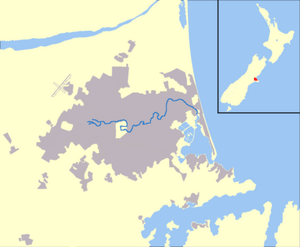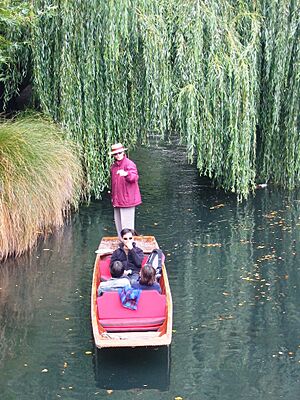Avon River / Ōtākaro facts for kids
Quick facts for kids Avon River / Ōtākaro |
|
|---|---|

Antigua boat sheds on the Avon, Christchurch
|
|

Course of the Avon River
|
|
| Country | New Zealand |
| Physical characteristics | |
| Main source | Avonhead |
| River mouth | Pegasus Bay via the Avon Heathcote Estuary 0 m (0 ft) |
| Length | 14 km (8.7 mi) |
The Avon River / Ōtākaro is a beautiful river in New Zealand. It flows right through the middle of Christchurch city. This river then joins an estuary (where a river meets the sea) with the Heathcote River. This shared area is called the Avon Heathcote Estuary.
Contents
Where the River Flows
The Avon River takes a winding path through Christchurch. It starts in a western suburb called Avonhead. From there, it travels through areas like Ilam, Riccarton, and Fendalton.
The river then goes through the famous Hagley Park. After that, it flows through the city's main business area, known as the CBD. Further east, it passes through Avonside, Dallington, Avondale, and Aranui. Finally, the Avon River empties into the Pacific Ocean. This happens through the Avon Heathcote Estuary (which is called Te Wahapū in Māori) near Sumner.
How the River Got Its Name
The Māori people had their own names for the Avon River. They called it Ōtākaro or Putare Kamutu. When the first European settlers arrived, they had different ideas for its name.
In 1848, a man named John Deans gave the river its current name. He named it after the Scottish Avon. This river was near his grandfather's farm in Scotland. The Deans family built their home right next to the Avon River in the area now known as Riccarton. Some people think the river was named after the Avon River in Stratford-on-Avon, where William Shakespeare was born. But this is just a coincidence!
In 1998, the river's name was officially changed. It became "Avon River / Ōtākaro." This was part of an important agreement with the Ngāi Tahu Māori tribe.
Fun on the River: Punting
One popular activity on the Avon River is punting. This is where you ride in a flat-bottomed boat. A person stands at the back and pushes the boat along with a long pole. It's a bit like a gondola ride!
You can go punting in the city centre. You can also find punting in Hagley Park and at Mona Vale. Mona Vale is a beautiful park in the Fendalton area. It's a fun way to see the city from the water.
Fishing in the Avon
The Avon River is a great spot for fishing. Many local anglers (people who fish) enjoy it. The river has a lot of Brown trout. These fish were brought to New Zealand from other countries.
In the parts of the river closer to the sea, you can catch very large trout. Some can weigh over 4 kilograms (10 pounds)! These big fish grow by eating many native "whitebait" fish. Further upstream, closer to the city, the trout are smaller. But there are more of them! Many people use fly fishing here. This is a special way of fishing where you use fake insects to attract the fish. It's important to know that you cannot fish in some parts of the river. This includes the area between the Armagh Street bridge and the Barbadoes Street bridge.
Earthquakes and the River
Christchurch has experienced several big earthquakes. These happened in 2010 and 2011. Much of the land along the Avon River, especially downstream from the city centre, was badly damaged. Because of this damage, some areas were marked as "red zones." This means the land is not safe for building homes anymore.
Many people in the community want to turn this red zone land into a large park. This park would connect the city centre all the way to the estuary. A group called Avon-Otakaro Network (AvON) is leading this effort. The mayor of Christchurch has also supported their idea.
After the earthquakes, health officials warned people not to swim in the river. This was because the water had become contaminated. The contamination was linked to the damage caused by the earthquakes.
In 2015, two sculptures were bought for Christchurch. They are called Stay and were made by an English artist named Antony Gormley. One of these sculptures was placed in the Avon River. The artist hoped his sculptures would help the city heal after the earthquakes. The second sculpture was placed at the Arts Centre. These were the first of Gormley's artworks to be placed in New Zealand.
See Also



